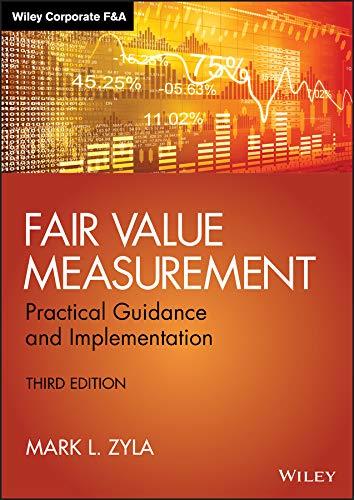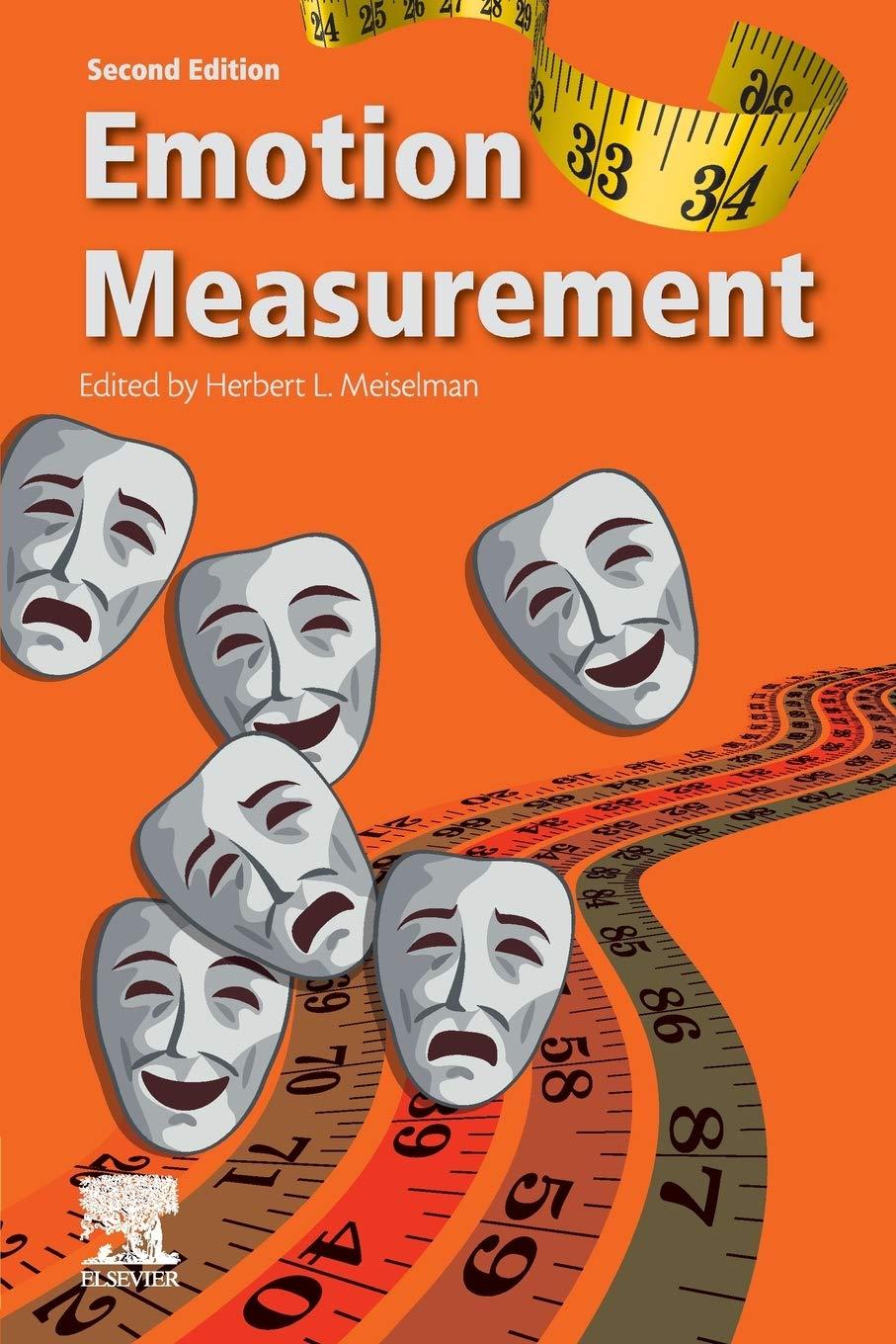Fair Value Measurement Third Edition Mark L. Zyla Visit to download the full and correct content document: https://ebookmass.com/product/fair-value-measurement-third-edition-mark-l-zyla/
More products digital (pdf, epub, mobi) instant download maybe you interests ...
Early Stage Valuation: A Fair Value Perspective 1st Edition Antonella Puca
https://ebookmass.com/product/early-stage-valuation-a-fair-valueperspective-1st-edition-antonella-puca/
Emotion Measurement 2nd Edition Herbert L. Meiselman
https://ebookmass.com/product/emotion-measurement-2nd-editionherbert-l-meiselman/
Macs for seniors 4th Edition Mark L Chambers
https://ebookmass.com/product/macs-for-seniors-4th-edition-markl-chambers/
Interpersonal Communication & Human Relationships Mark L. Knapp
https://ebookmass.com/product/interpersonal-communication-humanrelationships-mark-l-knapp/
The Membranes of Cells, Third Edition Philip L. Yeagle
https://ebookmass.com/product/the-membranes-of-cells-thirdedition-philip-l-yeagle/
Desarrollo embrionario Keith L. Moore & T.V.N. Persaud & Mark G. Torchia
https://ebookmass.com/product/desarrollo-embrionario-keith-lmoore-t-v-n-persaud-mark-g-torchia/
Emotion measurement 1st Edition Meiselman
https://ebookmass.com/product/emotion-measurement-1st-editionmeiselman/
Strategies for e-business : creating value through electronic and mobile commerce : concepts and cases Third Edition. Edition Enders
https://ebookmass.com/product/strategies-for-e-business-creatingvalue-through-electronic-and-mobile-commerce-concepts-and-casesthird-edition-edition-enders/
Tests & Measurement for People Who (Think They) Hate Tests & Measurement 3rd Edition – Ebook PDF Version
https://ebookmass.com/product/tests-measurement-for-people-whothink-they-hate-tests-measurement-3rd-edition-ebook-pdf-version/
FairValueMeasurement Foundedin1807,JohnWiley&Sonsistheoldestindependentpublishingcompanyinthe UnitedStates.WithofficesinNorthAmerica,Europe,Asia,andAustralia,Wileyisglobally committedtodevelopingandmarketingprintandelectronicproductsandservicesforour customers’professionalandpersonalknowledgeandunderstanding.
TheWileyCorporateF&Aseriesprovidesinformation,tools,andinsightstocorporateprofessionalsresponsibleforissuesaffectingtheprofitabilityoftheircompany,from accountingandfinancetointernalcontrolsandperformancemanagement.
©2020JohnWiley&Sons,Inc.Allrightsreserved.
PublishedbyJohnWiley&Sons,Inc.,Hoboken,NewJersey. PublishedsimultaneouslyinCanada.
Nopartofthispublicationmaybereproduced,storedinaretrievalsystem,ortransmittedinanyform orbyanymeans,electronic,mechanical,photocopying,recording,scanning,orotherwise,exceptas permittedunderSection107or108ofthe1976UnitedStatesCopyrightAct,withouteithertheprior writtenpermissionofthePublisher,orauthorizationthroughpaymentoftheappropriateper-copyfee totheCopyrightClearanceCenter,Inc.,222RosewoodDrive,Danvers,MA01923,(978)750-8400, fax(978)646-8600,orontheWebatwww.copyright.com.RequeststothePublisherforpermission shouldbeaddressedtothePermissionsDepartment,JohnWiley&Sons,Inc.,111RiverStreet, Hoboken,NJ07030,(201)748-6011,fax(201)748-6008,oronlineatwww.wiley.com/go/ permissions.
LimitofLiability/DisclaimerofWarranty:Whilethepublisherandauthorhaveusedtheirbesteffortsin preparingthisbook,theymakenorepresentationsorwarrantieswithrespecttotheaccuracyor completenessofthecontentsofthisbookandspecificallydisclaimanyimpliedwarrantiesof merchantabilityorfitnessforaparticularpurpose.Nowarrantymaybecreatedorextendedbysales representativesorwrittensalesmaterials.Theadviceandstrategiescontainedhereinmaynotbe suitableforyoursituation.Youshouldconsultwithaprofessionalwhereappropriate.Neitherthe publishernorauthorshallbeliableforanylossofprofitoranyothercommercialdamages,including butnotlimitedtospecial,incidental,consequential,orotherdamages.
Forgeneralinformationonourotherproductsandservicesorfortechnicalsupport,pleasecontactour CustomerCareDepartmentwithintheUnitedStatesat(800)762–2974,outsidetheUnitedStatesat (317)572-3993,orfax(317)572-4002.
Wileypublishesinavarietyofprintandelectronicformatsandbyprint-on-demand.Somematerial includedwithstandardprintversionsofthisbookmaynotbeincludedine-booksorin print-on-demand.IfthisbookreferstomediasuchasaCDorDVDthatisnotincludedintheversion youpurchased,youmaydownloadthismaterialathttp://booksupport.wiley.com.Formore informationaboutWileyproducts,visitwww.wiley.com.
NOTE:Anyviewsoropinionsrepresentedinthisworkarepersonalandbelongsolelytotheauthorand thosequotedorcited.Theydonotrepresentthoseofpeople,institutions,ororganizationsthatthey mayormaynotbeassociatedwithinanyprofessionalorpersonalcapacity,unlessexplicitlystated.
LibraryofCongressCataloging-in-PublicationDataisAvailable:
ISBN978-1-119-19123-0(hardback)
ISBN978-1-119-34891-7(ePDF)
ISBN978-1-119-34981-5(ePub)
CoverDesign:Wiley
CoverImage:©bluebay/Shutterstock
PrintedintheUnitedStatesofAmerica
10987654321
Tomywife,JoAnn,andmyson,Jack. Youmakethisallpossible … Andtomydad,LarryZyla, Thankyou … foreverything.
SubsequentAccountingforGoodwillandOtherIntangibleAssets99 Conclusion100 Notes101
Chapter4:TheNatureofGoodwillandIntangibleAssets103
HistoryofIntangibleAssets104 IntellectualProperty105 EconomicBasisofIntangibleAssets106 IdentificationofIntangibleAssets106 UsefulLifeofanIntangibleAsset111 IntangibleAssetsandEconomicRisk112 Goodwill112 EconomicBalanceSheet114 Conclusion116 Notes117
Chapter5:Impairment119
EvolutionofImpairmentTesting120 ApplicableFASBGuidanceforImpairmentTesting122 AccountingfortheImpairmentofLong-LivedAssets123 GoodwillImpairmentTesting—PublicCompanies125 GoodwillImpairment—One-StepImpairmentLoss138 TestingOtherIndefinite-LivedIntangibleAssetsforImpairment139 AmortizationofGoodwill139 Conclusion140
Economic(External)Obsolescence173 ApplyingtheCostApproach174 TaxesUndertheCostApproach178 LimitationsoftheCostApproach179 Conclusion179 Notes180
Chapter7:TheMarketApproach183 ApplyingtheMarketApproachWhenMeasuringtheFairValueofanEntityor aReportingUnitofanEntity184 Conclusion213 Notes213
Chapter8:TheIncomeApproach215 Introduction215 DiscountedCashFlowMethod216 MultiperiodExcessEarningsMethod223 FASBConceptsStatement7239 RatesofReturnUndertheIncomeApproach244 TheIncomeIncrement/CostDecrementMethod245 ProfitSplitMethod246 Build-Out,orGreenfield,Method251 WeightedAverageCostofCapitalCalculation251 Conclusion258 Notes259
Chapter9:AdvancedValuationMethodsforMeasuringtheFairValue ofIntangibleAssets261 Introduction261 LimitationsofTraditionalValuationMethods261 RealOptions263 UsingOptionPricingMethodologiestoValueIntangibleAssets266 Black-ScholesOptionPricingModel269 BinomialorLatticeModels272 MonteCarloSimulation277 DecisionTreeAnalysis280 Conclusion281 Notes281
Chapter10:MeasuringtheRemainingUsefulLifeofIntangibleAssets inFinancialReporting283 FASBGuidanceonDeterminingtheRemainingUsefulLife283 ConsiderationsinMeasuringUsefulLivesofIntangibleAssets285 PracticalGuidanceforEstimatingandModelingtheUsefulLife289 Conclusion295 Notes295
Chapter11:FairValueMeasurementforAlternativeInvestments297 Introduction297 InvestmentsinCertainEntitiesThatCalculatedNetAssetValueperShare299 AICPATechnicalPracticeAid300 AICPAGuidanceforDeterminingtheFairValueofInvestment301 AICPAAccountingandValuationGuide, ValuationofPortfolioCompany InvestmentsofVentureCapitalandPrivateEquityFundsandOther InvestmentCompanies 305 InternationalPrivateEquityandVentureCapitalValuationGuidelines306 CommonValuationMethodologiesofMeasuringtheFairValueoftheFund’s InvestmentPortfolio307 Conclusion308 Notes308
Chapter12:ContingentConsideration311
ContingentConsideration:Earn-outsinBusinessCombinations311 AccountingforContingentConsideration312 Conclusion324 Notes324
Appendix12A:MeasuringtheFairValueofaNonfinancialContingent Liability—ExampleofaLoanGuarantee327 TheJordanLeeFundGuaranteeofTownsendFarmDevelopment,LLC328 Notes334
Chapter13:AuditingFairValueMeasurement335
AuditingStandards336 TheAuditProcess338 EvolutionofAuditStandardsforFairValueMeasurementsandDisclosures342 AuditingStandard2501, AuditingAccountingEstimates,IncludingFairValue Measurements 344 AuditingStandardsforAuditor’sUseoftheWorkofSpecialists349 ProposedInternationalStandardonQualityManagement1354 PracticalGuidanceforAuditors354 PCAOBStaffAuditPracticeAlertNo.9, AssessingandRespondingtoRiskin theCurrentEconomicEnvironment 356 AICPANonauthoritativeGuidance358 TheAppraisalFoundation359 Conclusion359 Notes360
Preface FAIRVALUEMEASUREMENTSANDDISCLOSURES continuestobeanareaof tremendousinterestinfinancialreporting.AlthoughtheFairValueMeasurements frameworkisfullyconvergedunderU.S.GAAP(ASC820 FairValueMeasurements) andIFRS(IFRS13 FairValueMeasurements),bestpracticesofthemeasurementsthemselves havecontinuedtoevolve.Overthepast10years,organizationssuchastheAICPAandthe AppraisalFoundationhavedevelopedvariedguidanceonbestpracticesonmeasuringfair valueforvaluationspecialists.InDecember2018,thePCAOBfinalizedAS2501, Auditing AccountingEstimates,IncludingFairValue,andAS1201,Auditor’sUseofaSpecialist,toprovide additionalguidancetoauditorsinauditingfairvalue.Thevaluationprofessionrecently developedaFairValueQualityInitiativetoenhancethatprofession’sinvolvementinfinancial reporting,resultinginthenewCertifiedinEntityandIntangibleValuation(CEIV)credential andtheMandatoryPerformanceFramework(MPF).
InDecember2018,theInternationalAccountingStandardsBoardissuedareporton theirpostimplementationreviewofIFRS13, FairValueMeasurements.BoththeIASBand theFASBregularlyconductreviewsofnewlyimplementedaccountingstandardstoassess whetherthestandardsareworkingasintended.TheFASBconductedapostimplementation reviewin2014andconcludedthatthethen-titledFASBStatement157“metitsobjectives.”1 TheIASBconcludedthattheinformationrequiredbyIFRS13is“usefultousersoffinancial statements.”2
Investor-focusedorganizationssuchastheCFAInstitutehaveconcludedfromaseriesof surveysoftheirmembersthat“wherefairvaluehasbeenimplementedoverthepast15–20 yearsthereisgreateracceptanceastoitsappropriateness,relevanceandreliability.”3 A2013 CFAISurveyonFairValueAccounting&Long-TermInvestinginEuropesummarizesthe importanceoffairvaluemeasurementsinfinancialreportingtoinvestorsacrosstheglobe.
Simplyputallinvestorsbuy,sell,andholdtheirinvestmentsbasedonfairvalueinformation.Fairvalueinformationisnecessarytojudgecurrentfinancialhealth,isan inputtopredictingfutureperformance,andhelpsinthejudgmentofhoweffectively managementisfulfillingitsstewardshipfunction.4
Clearly,fairvaluemeasurementsenhancethepublictrustinfinancialreporting. Thethirdeditionof FairValueMeasurement:PracticalGuidanceandImplementation,which includessubstantialnewdiscussionmaterialandmanynewcomprehensiveexamples,isorganizedasfollows: xiii
Chapter1:TheHistoryandEvolutionofFairValueAccounting ◾ Providesahistoricallookatthedevelopmentoffairvalueconceptsandaccounting standards.
◾ Includesmilestonesrelatedtothedevelopmentoffairvalueforfinancialinstrumentsand fairvaluemeasurementofnonfinancialassetsandliabilities.
◾ Explainshowtheeconomiccrisisshapedfairvaluemeasurementandhowthecrisisled totherefinementofseveralaccountingstandards.
◾ DiscusseshowtheproposedconvergenceofU.S.GAAPwithIFRShasshapedfairvalue measurementconcepts,despitetheunlikelyfullconvergenceofbothstandards.
◾ Introducestrendsthatarelikelytocontinuetoaffectfairvaluemeasurementincluding differentlevelsofdisclosuresforpublicandprivatelyheldentities.
◾ IntroducestheFairValueQualityInitiativeandtheMandatoryPerformanceFramework.
◾ Includes,inanappendix,achecklistofitemstoconsiderundertheMandatoryPerformanceFramework.
Chapter2:FairValueMeasurementStandardsandConcepts ◾ PresentsanoverviewoffairvaluemeasurementinU.S.GAAPandwithcrossreferences toFASBASC820, FairValueMeasurement
◾ Examinesimportantfairvalueframeworkconceptssuchastheprincipalormostadvantageousmarket,marketparticipants,thehighestandbestusefornonfinancialassets, inputstofairvaluemeasurements,andthefairvaluehierarchy.
◾ DiscussedtheapplicationofFASBASC825, FinancialInstruments,whichprovidesthefair valueoptionforfinancialinstruments.
◾ Includesanexplanationofstandardsinthevaluationprofession,includingadiscussion ofUniformStandardsofProfessionalAppraisalPractice(USPAP)andInternational ValuationStandards(IVS).
◾ Provides,inanappendix,theimpactoftheTaxCutandJobsAct(TCJA)of2017onfair valuemeasurements.
Chapter3:BusinessCombinations ◾ Discussestherolemergerandacquisitiontransactionsplayinoureconomy,including trendsandpitfalls.
◾ Discussesthedevelopmentofaccountingstandardsforbusinesscombinations.
◾ CoverstherequirementsofASC805, BusinessCombinations.
◾ DiscussesprivatecompanyalternativeaccountingunderASU2014-18.
◾ Providescomprehensiveexamples.
Chapter4:TheNatureofGoodwillandIntangibleAssets ◾ Providesabriefoverviewofintangibleassetsandintellectualproperty,includingthe increasinglyprominentroletheseassetscontributetotheoverallbusinessenterprise value.
◾ Touchesonthecriteriaforrecognizinggoodwillandintangibleassetsinfinancialreportingandforestimatingtheirusefullives.
◾ ProvidestheclassificationandexamplesofintangibleassetsfromFASBASC805, Business Combination,aswellasmanyotherexamples.
Chapter5:Impairment ◾ Discussestheevolutionoftestinggoodwillforimpairmentundervariousaccounting standards.
◾ IncludesadescriptionofthealternativeaccountingforprivatecompaniesunderASU 2014-02.
◾ Includesadiscussionofthe“one-step”impairmenttestunderASU2017-04, Simplifying theTestforGoodwillImpairment.
◾ Coversthequalitativegoodwillimpairmenttestaswellasthechallengesoftheprior two-stepquantitativeimpairmenttest.
◾ Discussestheapplicableguidancefortestinggoodwill,intangibleassets,andlong-lived assetsforimpairmentandtheorderoftesting.
◾ Providesinsightintothediscussionaboutwhethergoodwillimpairmenttestingshould beattheequityorenterpriselevel.
◾ Includesanappendixwithacomprehensiveexampleofavaluationspecialist’sreportpreparedforaqualitativegoodwillimpairmentanalysis.
Chapter6:TheCostApproach ◾ Discussesthecostapproachtofairvaluemeasurement,includingtheeconomicbasisfor thecostapproach,theroleofexpectedeconomicbenefits,andeconomicobsolescence.
◾ Distinguishesbetweenreproductioncostandreplacementcost.
◾ Providesexamplesforapplyingthecostapproachusinghistoricaltrending,theunitcost methodandtheunitofcostmethod.
◾ Addresseshowtaxesandotherfactorsmayimpacttheapplicationofthecostapproach.
Chapter7:TheMarketApproach ◾ Coversmeasuringthefairvalueofanentityusingamarketapproachsuchastheguidelinepubliccompanymethodortheguidelinetransactionmethod.
◾ Providesinsighttocontrolpremiumsandsynergiesunderthismethod.
◾ Discussesthedevelopmentandapplicationofequityandinvestedcapitalmultiples.
◾ Coverstheapplicationofthemarketapproachtomeasurethefairvalueofintangible assets.
◾ Providesupdatedexamplesofuseofvarioustechniquesunderthemarketapproach.
Chapter8:TheIncomeApproach ◾ Examinestheworkhorseofvaluationmethods,thediscountedcashflowmethod,includingsingle-periodandmultiperiodvariations.
◾ Providesanin-depthlookatthemultiperiodexcessearningsmethod,includingmarket participantassumptionsinprojectedfinancialinformationandtheroleofcontributory assetsandtheirrequiredreturns.
◾ Providesexamplesofotherincomeapproachmethodsusedinbusinesscombinations, suchastheprofitsplitmethodandthe“withandwithout”method.
◾ Addressestheweightedaveragecostofcapitalanditscalculationunderthebuild-up methodandthecapitalassetpricingmodel.
◾ Providesupdatedexamplesofvariousvaluationtechniquesunderthemarketapproach.
Chapter9:AdvancedValuationMethodsforMeasuringtheFairValueof IntangibleAssets ◾ Introducesadvancedvaluationtechniquessuchastheoption-pricingmethods,Monte Carlosimulation,anddecisiontreeanalysis.
◾ Discussesrealoptionsderivedfromtheownershiprightsofintangibleassetsandhowto measuretheirfairvalue.
Chapter10:TheRemainingUsefulLifeofIntangibleAssets ◾ Distinguishesbetweenfinite-livedassetsandindefinite-livedassets.
◾ Providesfactorstoconsiderwhenmeasuringtheusefullivesofintangibleassets,includingthelegal,contractual,andusefullives.
◾ Providesexamplesofvariousapproachestocalculatingtheremainingusefullivesof intangibleassets.
Chapter11:FairValueMeasurementofAlternativeInvestments ◾ Discussesauthoritativeguidancefordeterminingthefairvaluemeasurementofalternativeinvestments,includingrecentAICPATechnicalPracticeAids.
◾ Addressesthepracticalexpedientforinvestmentsthatcalculatenetassetvaluepershare.
◾ Distinguishesinitialduediligencefeaturesofanalternativeinvestmentfromongoing monitoringfeatures.
◾ DiscussesthenewAICPAAccountingandValuationGuide, ValuationofPortfolioCompany InvestmentsofVentureCapitalandPrivateEquityFundsandOtherInvestmentCompanies
Chapter12:ContingentConsideration ◾ Discussestheaccountingrecognitionofearn-outsandothercontingentconsiderationin businesscombinations.
◾ Discussesthecommonwaysthatearn-outclausesareusedtoresolvepricedifferences betweenbuyersandsellersinabusinesscombination.
◾ Providesexamplesofmeasuringthefairvalueofcontingentconsiderationusinga probability-weightedexpectedreturnmethod,theBlack-Scholesoptionpricingmodel, andMonteCarlosimulation.
◾ AnappendixtoChapter12explainshowtomeasurethefairvalueofaloanguarantee usingtheBlack-Scholesoptionpricingmodelandincludesacasestudyexampletoillustratetheconcepts.
Chapter13:AuditingFairValueMeasurement ◾ DiscussestheguidanceforauditingfairvaluemeasurementsinAU328.
◾ IncludesadiscussiononthePCAOB’snewauditingstandardsAS2501, AuditingAccountingEstimates,IncludingFairValue,andAS1201,Auditor’sUseofaSpecialist
◾ IncludesimportanttopicsfromPCAOBAlertNo.2,includingauditingfairvalue measurements,classificationwithinthefairvaluehierarchy,andusingtheworkofa valuationspecialistorapricingservice.
◾ DiscussesthePCAOBAlertNo.9, AssessingandRespondingtoRiskintheCurrentEconomic Environment
◾ AppendixesAandBprovideexamplesofissuesauditorsmayconsiderwhenauditing businesscombinationsandone-stepgoodwillimpairmenttests.
◾ AppendixCexaminestheresultsofPCAOBinspectionreportsinAcuitas,Inc.’sSurveyof FairValueAuditDeficiencies.
Chapter14:FairValueMeasurementCaseStudy ◾ Providesanewstreamlinedcomprehensivebusinesscombinationcasestudywithvaluationmodelsillustratingthemeasurementoffairvalueforintangibleassets.
◾ Coversimportanttopicssuchastheacquisitionprice,contingentconsideration,business enterprisevalue,theweightedaveragecostofcapital,identifyingintangibleassets,goodwill,abargainpurchase,andsubsequenttestingforimpairmentofgoodwill.
◾ Highlightsimportantcasestudyconceptsthroughaquestion-and-answerformatwith suggestedsolutions.
AsInotedintheprefaceofthefirsttwoeditions,somehavevoicedconcernsaboutthe cost-benefitassociatedwithmeasuringfairvalueinfinancialreporting.However,asreported bytheaccountingstandardsettersandtheCFAInstitute,thebenefitsoffairvalueinfinancial reportingareclearlyevident.Fairvaluemeasurements,however,dorequireacertainamount ofjudgmentandexpertise.Clearly,therearesomechallenges.However,thebenefitstousersof financialstatementsthatincludefairvaluemeasurementsvastlyoutweighthosechallenges. Hopefullythisthirdeditionwillcontinuetohelpwiththosechallenges.
NOTES 1. ResponseoftheFinancialAccountingStandardsBoardonthePost-ImplementationReviewof FAS157,letterfromRussGolden,ChairoftheFASB,totheFinancialAccountingFoundation, datedMarch10,2014.
2. Post-ImplementationReviewofIFRS13,FairValueMeasurement,December2018,www .ifrs.org.
3. “SummaryofCFAInstituteMemberSurveys,”September2010,www.cfa.institute.org.
4. “ValueAccounting&Long-TermInvestinginEurope,”CFAInstitute,September2013,www .cfainstitute.org.
Acknowledgments MOSTIMPORTANTLY, IwanttothankLynnPiersonforherassistancewiththis book.WithoutLynn’sefforts,thisthirdeditionaswellasthefirstandsecond, wouldnothavebeencompletedwithnearlythequalityanddepth.
Finally,thankyoutothosewhoprovidedcommentsandsuggestionsonvariousaspects offairvaluemeasurementswhichwereinstrumentalinpreparingthisthirdeditionaswell asthefirstandsecond,including:BillKennedyofDuff&Phelps;JulieDelongofAnkura ConsultingGroupLLC;TeresaThamerofBrenauUniversity;BrianSteenofDixonHughes GoodmanLLP;BrentSolomonoftheUniversityofMaryland;TaraMarinooftheCohnReznick LLP;MarkEdwardsofGrantThorntonInternationalLtd;MichaelBlakeofArpeggioAdvisors; JohnLinofMcKessonCorporation;AdrianLoudofCenseoAdvisorsLLC.;TracyHaasof RoarkCapitalGroup;HaroldMartin,PeterThackerandBrianBurnsofKeiter;Bernard PumpofDeloitteLLP;JimDonderoofAndersen;EllenLarsonofFTIConsulting;Steve HydenofWashingtonPartners;DavidDufendachofAlverez&Marsal;EdKetzofPennState University;NeilBeatonofAlvarez&Marsal;TomRyanoftheLeventhalSchoolofAccounting atUniversityofSouthernCaliforniaandProfessorMauroBiniofBocconiUniversityand ChairmanoftheManagementBoardofOIV—OrganismoItalianodiValutazione.
Theseindividuals’comments,aswellasthoseofmanyothers,wereinvaluableinmy preparationofthisbook.Anyerrors,however,aremyown.
TheHistoryandEvolution ofFairValueAccounting FAIRVALUEACCOUNTING haschangedthewayfinancialinformationispresented.Whereoncefinancialstatementswerebasedprimarilyonhistoricalcosts, undercertaincircumstances,fairvalueisoftenthebasisofmeasurementforreporting forbothfinancialandnonfinancialassetsandliabilities.Measuringfairvalueoftenrequires experienceandjudgment,andithasthepotentialtointroducebiasintofinancialstatements. Atrendtowardincreasingtheamountoffinancialstatementinformationpresentedor disclosedatfairvaluepersistsunderU.S.generallyacceptedaccountingstandards(GAAP) andInternationalFinancialReportingStandards(IFRS).Thetrendawayfromhistorical costs,whichhasbeenthebedrockoftraditionalaccounting,towardfairvalueaccounting hasbeenchallengingforpreparers,auditors,standardssetters,andregulators.
Fairvalueaccountingisafinancialreportingapproachthatrequiresorpermitsentities tomeasureandreportassetsatthepriceassetswouldsellandliabilitiesattheestimatedprice thataholderwouldhavetopayinordertodischargetheliability.Theterm fairvalueaccounting notonlyreferstotheinitialmeasurementbutcanalsorefertosubsequentchangesinfair valuefromperiodtoperiodandthetreatmentofunrealizedgainsandlossesinthefinancial statements.Therefore,fairvalueaccountingaffectsthereportedamountsforassetsandliabilitiesinthebalancesheetandaffectsthereportedamountsforunrealizedgainsorlosses shownintheincomestatementorintheothercomprehensiveincomesectionofshareholders’equity.Infinancialreporting,fairvalueaccountingisoftenappliedtofinancialinstrumentssuchasinvestmentsinstocks,bonds,anentity’sowndebtobligations,andderivative instrumentslikeoptions,swaps,andfutures.Whenunadjustedoradjustedmarketpricesare thebasisforfairvalueestimatesoffinancialassetsandliabilities,theprocessisoftencalled mark-to-marketaccounting.
Fairvalueaccountingisapplicabletononfinancialassetsandliabilitiesaswell,butin morelimitedcircumstances.Forinstance,whenanentityisacquiredinabusinesscombination,allbalancesheetassetsandliabilitiesarerecordedatfairvalue.Subsequenttothe acquisitiondate,fairvalueisthebasisfortestingacquiredgoodwillforimpairment.Likewise, fairvalueisthebenchmarkwhentestingproperty,plant,andequipmentandamortizable intangibleassetsforimpairment.
Fairvaluemeasurementistheprocessfordeterminingthefairvalueoffinancialandnonfinancialassetsandliabilitieswhenfairvalueaccountingisrequiredorpermitted.Therefore, fairvaluemeasurementisbroaderthanmark-to-marketaccounting.Itencompassesestimatingfairvaluebasedonmarketpricesaswellasestimatingfairvalueusingvaluationmodels. TheFinancialAccountingStandardsBoards(FASB)AccountingStandardsCodification(ASC) 820, FairValueMeasurement, providesauthoritativeguidanceformeasuringthefairvalueof assets,liabilities,andequityinterestswhenfairvalueaccountingisrequiredorpermittedin otheraccountingstandards.TheInternationalAccountingStandardsBoard(IASB)hasan identicalstandard,IFRS13, FairValueMeasurements.
Advocatesoffairvalueaccountingbelievethatfairvaluebestrepresentsthefinancial positionoftheentityandprovidesmorerelevantinformationtotheusersofthefinancial information.Detractorsbelievethatfairvaluesareunreliablebecausetheyaredifficulttoestimate.Criticsalsobelievethatreportingtemporarylossesismisleadingwhentheyarelikelyto reverse,andthosecriticsbelievethatreportedlossesadverselyaffectmarketpricesandmarket risk.1 Inspiteofthecriticism,fairvalueaccountinghasbecomemoreprominentinfinancialstatementpresentationandwillcontinuetobeafundamentalbasisforaccountinginthe future.
InDecember2018,theIASBpublishedapostimplementationreviewofIFRS13, Fair ValueMeasurements,whichisconductedperiodicallybyboththeIASBandtheFASBtodeterminewhetheraccountingstandardsareworkingasintended.Inasummaryoftheirfindings, theIASBconcludedthefollowing:
◾ “TheinformationrequiredbyIFRS13isusefultousersoffinancialstatements.
◾ SomeareasofIFRS13presentimplementationchallenges,largelyinareasrequiring judgment.However,evidencesuggeststhatpracticeisdevelopingtoresolvethese challenges.
◾ NounexpectedcostshavearisenfromapplicationofIFRS13.2
TheIASBfurtherconcludedthatthefindingsofthepostimplementationreviewonfair valuemeasurementsshouldbeincorporatedintotheprojectaboutbettercommunicationin financialreporting.TheBoardalsoconcludedthatitneededtobetterliaisewiththevaluation profession,includingmonitoringnewdevelopmentswithvaluationspecialists.
WHYTHETRENDTOWARDFAIRVALUEACCOUNTING? Inrecentyears,therehasbeenanincreasingtrendtowardtheuseoffairvalueaccounting infinancialreporting.Evenwhenfairvalueaccountingisnotrequiredandfinancialstatementsarepreparedusingsomeothermeasurementbasis,thereisalikelihoodthatrelated
disclosureswillrequirethepresentationoffairvalueinformation.Severalfactorsareinfluencingthetrendtowardfairvalueaccounting:thegrowingeconomicimportanceofintellectual property,globalization,andinvestors’desireforfinancialstatementsthataremorerelevant andtransparent.
TheChangingEconomy TheeconomyintheUnitedStateshasundergonetremendouschangesoverthepast quarter-centuryduetoarapidrateoftechnologicalinnovation.Theexplosionintheuseof personalcomputersanddigitalmediahascreatedwholeindustriesthatdidnotpreviously exist.Oneproductoftechnologicalinnovationthatcontributedtoeconomicchangeisthe commercializationoftheInternet,whichresultedinwhatsomecallthe informationrevolution. TheresultofthistechnologicalandeconomicchangeisthatasignificantportionoftheU.S. economyshiftedfrombricks-and-mortarbusinessestoinformation-basedbusinesses.
Thiseconomicchangehasledtoagrowingrecognitionthatthevaluedriverofmany businessentitieslieswithintheirintellectualproperty,notjustintheirinventory,plant,and equipment.Financialstatementusersalsorecognizethatintellectualpropertyhasnotbeen effectivelymeasuredundertraditionalcost-basedaccountingpractices.Thereasonisthat existingaccountingprinciplesrequireinternallycreatedintellectualpropertytobeexpensed asresearchanddevelopment.
OceanTomo,anintellectualcapitalmerchantbankingfirm,producesanAnnualStudy ofIntangibleAssetMarketValuethatbreaksdowntheStandard&Poor(S&P)500’sequity marketvalueintoanimpliedintangibleassetvalueandatangibleassetvalue.In2015, tangibleandfinancialassetsgeneratedapproximately13percentoftheS&P500’smarket value.Whiletangibleandfinancialassetsarereflectedoncompanybalancesheets,the remaining87percentofvalueattributabletointangibleassetsisoftennotrecognizedatall.3
Themarket-to-bookratiofortheS&P500asofDecember31,2018,wasapproximately2.944 Thisratioindicatesthatonlyaboutathirdofthevalueofthemarketcapitalizationonaverage isrecognizedbycurrentaccountingstandards.Thisvaluegaphasincreasedinrecentyears, highlightingtheincreasingimportanceofintangibleassets(includingintellectualproperty) intheoverallmarketcapitalizationofpubliclytradedcompanies.
Globalization TheInternationalMonetaryFunddefines economicglobalization as“ahistoricalprocess;the resultofhumaninnovationandtechnologicalprocess.Itreferstotheincreasingintegrationof economiesaroundtheworld,particularlythroughthemovementofgoods,servicesandcapitalacrossborders.”Globalizationhasacceleratedsincethe1980sasaresultoftechnological advancesthatmadeinternationalfinancialandtradingtransactionseasierandquicker.5 This increasingglobalizationofbusinesshascreatedaneedforconsistentaccountingstandards acrossnationalboundaries.
TheFASBandtheIASBrecognizethatusersoffinancialstatementswouldbenefitfrom havingonesetofinternationalaccountingstandardsthatcouldbeusedfordomesticand international,cross-borderfinancialreporting.Asaresult,bothorganizationshavebeen workingforseveralyearstojointlycreateaccountingstandardsandtoconvergeU.S.GAAP
withinternationalaccountingstandards(IAS).AccordingtotheFASB, convergence refersto boththegoalofestablishingasinglesetofhigh-qualityinternationalaccountingstandards andthepathtakentoreachthatgoal,whichincludesthecollaborativeefforts“toimprove existingU.S.GAAPandInternationalFinancialStandardsandeliminatethedifferences betweenthem.”6 Historically,IAShavebeenmoreprincipalbased,requiringmorefairvalue measurementthanU.S.GAAP,whichareconsideredmorerulesbased,requiringmore cost-basedmeasurement.Astheaccountingstandardsconverge,U.S.GAAPisrequiring morefairvalueaccountingmeasures.
ThehistoryandevolutionoffairvaluemeasurementencompassestherecentconvergenceofU.S.GAAPandIASpertainingtofairvaluemeasurement.Thefive-yearjointFASB andIASBprojectwasundertakentoimproveandalignfairvaluemeasurementanddisclosure requirementsandtorespondtotheglobalfinancialcrisis.7 Asoriginallypromulgated,the FASB’sStatementofFinancialAccountingStandards(SFAS)157, FairValueMeasurementsand Disclosures,influencedthedevelopmentofInternationalFinancialReportingStandard(IFRS) 13, FairValueMeasurement.ConvergencehasshapedU.S.accountingstandardsthrough updatestoFASBASC820.TheFASB’sAccountingStandardsUpdate(ASU)2011-04, AmendmentstoAchieveCommonFairValueMeasurementandDisclosureRequirementsinU.S. GAAPandIFRS,whichwasissuedinMay2011,eliminatedmostofthesignificantremaining differencesbetweenU.S.andinternationalaccountingstandardsformeasuringfairvalue. ThemoveandsubsequenthaltingoftheConvergenceProjectasitpertainstofairvalue measurementsisdiscussedingreaterdetailinthischapter.
RelevanceandTransparency Animportantcharacteristicofefficientcapitalmarketsisthatpricesaretheresultofthe market’scorrectassessmentofallavailableinformation.TheFASBrecognizesthatbetter financialreportingleadstostrongercapitalmarketsbyhelpinginvestorsmakeinformed decisions.OneoftheFASB’sstatedgoalsis“tosetaccountingstandardsthatproducefinancial informationusefulinhelpinginvestorsdecidewhethertoprovideresourcestoacompany, andwhetherthemanagementofthatcompanyhasmadegooduseoftheresourcesit alreadyhas.”8
Inanefforttomakefinancialreportingmorerelevanttoinvestors,theFASBhasencouragedinvestorstoparticipateintheaccountingstandardsprocessbyprovidingcommentson discussionpapersandexposuredraftsthatareissuedatvariousstagesoftheFASB’sprojects. TheFASBhasaskedinterestedinvestorstoprovideexpertadvicetotheFASB’sdesignated“investorliaison”staffmembersinconjunctionwithFASBprojects.Thegoalistoimprovethe relevanceofaccountingstandardsforinvestorsinacost-effectivemanner.
TwootherinvestoradvisorygroupsprovideinputtotheFASBfromtheinvestorperspective,theInvestorsTechnicalAdvisoryCommittee(ITAC)andtheInvestorTaskForce(ITF). TheITACisfocusedonprovidingtechnicalaccountingadviceandincreasinginvestorparticipationinstandardsetting.9 TheITFismadeupofinstitutionalassetmanagerswhoanalyzevarioussectorsoftheeconomy.TheITFprovidesadvicetotheFASBabouttheimpactof variousaccountingstandardsproposalsonspecificindustrysectors.10
TheSecuritiesandExchangeCommission(SEC)isequallycommittedtoadvancinghigh qualityaccountingstandardsthatareresponsivetoinvestors’needs.Intestimonybeforea Congressionalsubcommittee,SECDirectorJohnM.Whitesaid,
Anopenprocessthatallowsstandardssetterstoseekandthoughtfullyconsiderthe viewsofmarketparticipantsiscriticaltoestablishing,maintaining,andcontinuallyimprovingfinancialaccountingandreportingstandards.Wearecommittedto highqualityaccountingstandardsandatransparentfinancialreportingsystemthat meetstheneedsofinvestorsandothermarketparticipants.11
Transparencyinfinancialreportingistheunbiased,clear,completepresentationof acompany’sfinancialposition.Informationinthemanagementdiscussionandanalysis (MD&A)sectionofthefinancialstatementsaboutexistingriskanduncertaintyandabout thelikelyfutureimpactofriskanduncertaintyonthecompany’sprospectsfurtherpromotes transparency.Whenfinancialreportingistransparent,investorsarebetterabletomake decisionsandavoidsurprises.Onamacroeconomicscale,transparencyleadstomore efficientallocationofcapitalandstrongercapitalmarkets.Intheaftermathoftheeconomic crisis,therewasadebateaboutwhetherfairvalueaccountingpromotedfinancialstatement transparencyorwhetheritcausedthemeltdown.Ina2008reporttoCongress,theSECfound that“investorsgenerallybelievethatfairvalueaccountingincreasesfinancialreporting transparencyandfacilitatesbetterinvestmentdecision-making.”12 TheCFACenterfor FinancialMarketIntegrityconcurswiththeSEC’sview.Itsupportsfairvalueas“themost transparentmeasurementforinvestorstoanalyzefinancialstatements,”anditsaid,“fair valueisbeingusedasascapegoatbycorporationswhohavemadepoordecisionsorwerenot incompliancewithaccountingstandards.”13
ThefinancialcrisishaspresentedachallengeandanopportunityfortheSECandthe FASBtoreaffirmtheirmissionsandassesstheirsuccessinachievingtheirgoals.TheSEC’s missionisto“protectinvestors,provideforefficientmarkets,andtofacilitatecapitalformation.”14 TheFASB’smissionis“toestablishandimprovestandardsoffinancialaccounting andreportingthatfosterfinancialreportingbynongovernmentalentitiesthatprovides decision-usefulinformationtoinvestorsandotherusersoffinancialreports.”15 TheSECand theFASBhaverenewedtheireffortstoensuregreatertransparencyinfinancialreporting anditsrelevancetoinvestorssincethefinancialcrisisbeganandarelikelytocontinuetodo sofortheforeseeablefuture.
HISTORYANDEVOLUTIONOFFAIRVALUE TheFASB’sAccountingStandardsCodification(ASC)isthesingle,authoritativesourcefor U.S.GAAPtoday.ASCsupersededallpreviouslyissuedU.S.GAAPaccountingstandardsand reorganizedthembytopic.ASCbecameeffectiveforinterimandannualperiodbeginningafter September15,2009.16 ASC820, FairValueMeasurement (ASC820),supersededtheoriginal FASBaccountingstandardSFAS157thatwasissuedin2006.Inaddition,anyFASBStaff PositionsthatamendedSFAS157havealsobeensupersededbyASC820.FASBAccounting
StandardsUpdatesareincludedintheCodificationoncetheyreachtheireffectivedate.Those thathavenotreachedtheireffectivedatearepresentedinseparate“pendingcontent”sections, adjacenttothesubtopictheywillreplace.ASU2011-04, AmendmentstoAchieveCommonFair ValueMeasurementandDisclosureRequirementsinU.S.GAAPandIFRS, iseffectiveforallentitieswithreportingperiodsbeginningafterDecember15,2011.Sincethisdiscussioninthis sectionpertainstothehistoryoffairvaluemeasurements,thereferencesareasthestandards wereoriginallypresentedunderGAAP,muchofwhichhasnowbeencodifiedundertheASC. Fairvalueaccountingisnotanewrequirementinfinancialreporting.Fairvaluehasbeen astandardofmeasurementinfinancialreportingfordecades.TheFASBhasissueddozensof statementsthatusefairvalueasthemeasurementofvalue.Theconceptofvaluecontained inthesestatementsisfromamarketperspective,notfromtheperspectiveofthereporting entity.Therefore,measuringfairvaluerequiresfinancialstatementpreparerstousejudgmentandtomakeassumptionsconsistentwiththosemadebyothermarketparticipants.The FASBhasalsoissuedafewstatementswithfairvalue–likemeasurementstandardssuchas FASBASC718, Compensation—StockCompensation.Themaindifferencebetweenthesetwo measurementstandardsisthatthefairvalue–likemeasurementstandarddoesnotincorporateanexitpriceassumptionandfairvaluedoes.Theassumptionsunderlyingthefairvalue measurementframeworkofASC820arecoveredinChapter2.
InSeptember2006,theFASBissuedSFAS157(nowcodifiedasASC820)toclarifythe conceptsrelatedtothemeasurementoffairvalueandtoprovidefurtherimplementation guidance.17 AccordingtotheFASB,thereasonforissuingSFAS157wastodefinefair value,establishaframeworkformeasuringfairvalue,andexpanddisclosureaboutfair valuemeasurements.18 SFAS157didnotintroduceanynewaccountingrequirements. Instead,itappliedtoallexistingaccountingstatementsthatrequireassetsorliabilitiestobe presentedordisclosedinfinancialstatementsatfairvalue.Asoriginallypromulgated,the FASBintendedSFAS157toprovideoneuniformstatementunderwhichtheconceptoffair valuewouldbemorefullyexplained.
Whenitwasoriginallyissued,SFAS157becameasourceofcontroversyintheUnited States.Thebankingindustrywasparticularlyvocalinitsobjectionstomark-to-market accounting.Manycriticizeditsapplicationtoliabilities,andpreparersfelttheyneededmore guidancetoapplytheStatementtononfinancialassetsandliabilities.Inresponsetopressures fromfinancialstatementpreparersandotherconstituents,theFASBannouncedthatitwould delayimplementationfornonfinancialassetsandliabilitiesforoneyear.Theannouncement cameafewdaysbeforetheStatement’soriginalscheduledimplementationdate.Thereason citedbytheFASBforthepartialimplementationwas“toallowtheBoardandconstituents additionaltimetoconsidertheeffectofvariousimplementationissuesthathavearisen,or thatmayarise,fromtheapplicationofStatement157.”19
Eventhepartialimplementationdidnotallayallthecontroversy.Somecriticsoffairvalue accountingclaimedthatthecreditcrisisthatbeganin2008wasexacerbatedbyfinancial institutions’implementationofSFAS157.TheStatementbecamefullyeffectiveforfiscalyears beginningafterNovember15,2008,forallitems,includingfinancialandnonfinancialassets andliabilitiesrequiredunderexistingstatementstobemeasuredatfairvalue.
Inordertobetterunderstandfairvaluemeasurement,thissectioncoversthehistoryand evolutionoffairvaluemeasurementinfinancialreporting.Itbeginswithahistoricallook
backatthedevelopmentoffairvalueconcepts.Thenitcoverssomeofthemoreimportant milestonesrelatedtothedevelopmentoffairvalueforfinancialinstrumentsandfairvalue measurementfornonfinancialassetsandliabilities.Theeconomiccrisisshapedfairvalue measurementandledtotherefinementofseveralaccountingstandardsandconceptsasregulatorsandstandardssettersrespondedtothecrisis.ConvergenceofU.S.GAAPandIAShas alsoshapedfairvaluemeasurementconcepts.Finally,thissectionendsbydiscussingsome trendsthatarelikelytoinfluencethefutureoffairvaluemeasurement.
DevelopmentofFairValueConcepts Theconceptoffairvaluehasbeenevolvingforoveracentury.Inan1898U.S.SupremeCourt caseaboutrailroadrateregulation, Smythv.Ames, theCourtdiscussedsomeoftheconcepts underlying fairvalue bysaying:
Inordertoascertainthatvalue,theoriginalcostofconstructions,theamount expendedinpermanentimprovements,theamountandmarketvalueofitsstocks andbonds,thepresentascomparedtotheoriginalcostofconstruction,theprobable earningcapacityofthepropertyunderparticularratesprescribedbystatute,and thesumrequiredtomeetoperatingexpenses,areallmattersforconsideration, andaretobegivensuchweightasmaybejustandrightineachcase.Wedonot saythattheremaynotbeothermatterstoberegardedinestimatingthevalueof theproperty.20
Thisreferencetofairvaluealludestoseveralfairvaluemeasurementconceptsthat arecurrentlyinuse,suchasacostapproach,amarketapproach,economicvalue,andthe applicationofjudgmenttoweighthevariousindicationsofvalue.
TheFASBinitiallyconsideredadoptingthesamedefinitionof fairmarketvalue usedfortax reportingrequirements,andusingittodescribefairvalueinfinancialreporting.However, theFASBultimatelydecidedonauniquedefinitionfor fairvalue;therefore,theterms fairvalue and fairmarketvalue arenotinterchangeable.Thefairmarketvaluedefinitionfoundinthe InternationalGlossaryofBusinessValuationTerms isthesameasthetaxdefinitionoffairmarket valueinRevenueRuling59-60,whichstatesthatitis
theprice,expressedintermsofcashequivalents,atwhichpropertywouldchange handsbetweenahypotheticalwillingandablebuyerandahypotheticalwillingand ableseller,actingatarm’slengthinanopenandunrestrictedmarket,whenneither isundercompulsiontobuyorsellandwhenbothhavereasonableknowledgeofthe relevantfacts.21
Fairmarketvalueisthestandardofvalueinallfederalandstatetaxmatters.Itisoftenusedto valueownershipinterestsinentities,whichisconsistentwithitstransaction-baseddefinition. Theterm fairmarketvalue hasasignificantbodyofinterpretivecaselaw,whichwastheprimaryreasontheFASBdecidedtoadoptadifferentstandardofvaluewithaspecificdefinition forfinancialreporting.22
Fairvalueisthestandardforfinancialreportingpurposes. Fairvalue isdefinedinthe FASB MasterGlossary as“thepricethatwouldbereceivedtosellanassetorpaidtotransferaliability inanorderlytransactionbetweenmarketparticipantsatthemeasurementdate.”23
Although fairmarketvalue hasarichhistorywithrespecttolegalandtaxmatters,the applicationoffairvaluetofinancialreportingisarelativelynewdevelopment.Thissection looksatthedevelopmentoffairvalueconceptsinfinancialaccountingstandardsfroma historicalperspective.
Oneofthefirstaccountingstatementsrequiringtheuseoffairvalueinfinancialreporting wasAccountingPrinciplesBoard(APB)18, TheEquityMethodofAccountingforInvestmentsin CommonStock, whichwasissuedin1971.APB18introducedtheequitymethodofaccountingforinvestmentsinunconsolidatedsubsidiaries.UnderAPB18,alosswouldberecognized whentheinvestment’sfairvaluedeclinedbelowitscarryingvalueandthelosswasconsidered tobeotherthantemporary.24
APB29, AccountingforNonmonetaryTransactions, introducedin1973,outlinedwaysto measurethefairvalueofnonmonetarytransactions.Itindicatesthatthefairvalueofanonmonetarytransactionshouldbedeterminedbyreferringtocashtransactionsforthesameor similarassets,quotedmarketprices,independentappraisals,andtheestimatedfairvalueof theassetorservicereceived.Anydeterminationoffairvalueusingthesemethodswouldalso havetoconsiderwhethertheestimatedvaluewouldberealized.25
In1977,SFAS15, AccountingbyDebtorsandCreditorsforTroubledDebtRestructurings, establishedsomeimportantfairvalueconcepts.SFAS15specifiesthatfairvalueistheamount determinedthroughacurrentsalebetweenawillingbuyerandawillingseller,otherthanin aforcedorliquidationsale.Italsostates,
Fairvalueofassetsshallbemeasuredbytheirmarketvalueifanactivemarketfor themexists.Ifnoactivemarketexistsfortheassetstransferredbutexistsforsimilar assets,thesellingpricesinthatmarketmaybehelpfulinestimatingthefairvalueof theassetstransferred.Ifnomarketpriceisavailable,aforecastofexpectedcashflows mayaidinestimatingthefairvalueofassetstransferred,providedtheexpectedcash flowsarediscountedataratecommensuratewiththeriskinvolved.26
SFAS15establishedseveralimportantcriteriaforusingamarketapproachandestablished theuseofadiscountedcashflowmethodformeasuringfairvalue.Theseimportantconcepts persistinfinancialreportingtoday.
FairValueofFinancialInstruments TheFASBhasissuedseveralaccountingstandardsthatapplytofinancialinstrumentsincludingderivatives.OneofthefirstwasSFAS2, AccountingforCertainMarketableSecurities.Issued in1975,SFAS2requiredthatmarketablesecuritiesbecarriedatthelowerofcostormarket value.Italsoestablishedthepracticeofrecordingchangesinthemarketvalueofanentity’s noncurrentassetportfolioinaseparatecomponentofequity.Therefore,itpermittedunrealizedlossestobypasstheincomestatement.
In1991,SFAS107, DisclosuresAboutFairValueinFinancialInstruments, requiredthefair valuedisclosureofanentity’sfinancialinstruments.Therequirementincludedallfinancial assetsandliabilities,whetherrecordedorunrecordedinthefinancialstatements.27
SFAS115, AccountingforCertainInvestmentsinDebtandEquitySecurities,wasintroducedin1993.Itestablishedthreecategoriesofinvestmentsecurities:held-to-maturity
debtsecurities,tradingsecurities,andavailable-for-salesecurities.SFAS115alsorequiresfair valueasthestandardofmeasurementfordebtandequitysecuritiesclassifiedaseithertrading oravailable-for-sale.Unrealizedchangesinthefairvalueoftradingsecuritiesarerecognized inearnings,whereastheunrealizedchangesinthefairvalueofavailable-for-salesecurities areexcludedfromearningsandreportedinaseparatecomponentofshareholdersequity.28
In1994,theFASBissuedSFAS119, DisclosureAboutDerivativeFinancialInstrumentsand FairValueofFinancialInstruments.Itrequiredentitiesthatholdorissuederivativefinancial instrumentsfortradingpurposestodisclosetheaveragefairvalueofthoseinstruments.SFAS 119alsorequiredthatfairvalueinformationbepresentedwithoutcombining,aggregating, ornettingthefairvalueofderivativefinancialinstrumentswiththefairvalueofnonderivative financialinstruments.29
In2000theFASBintroducedFAS133, AccountingforDerivativeInstrumentsandHedging Activities,whichrequiredfairvalueasthemeasurementforderivativesecurities.Theaccountingtreatmentforchangesinthefairvalueofderivativeinstrumentsdependsontheirclassificationasafairvaluehedge,acashflowhedge,aforeigncurrencyhedge,oraderivative instrumentnotdesignatedasahedginginstrument.30
WiththeissuanceofSFAS159, TheFairValueOptionforFinancialAssetsandFinancial Liabilities,in2007,theFASBexpandedfairvaluemeasurementsforfinancialinstruments, whichwasconsistentwiththeBoard’slong-termaccountingmeasurementobjectivesfor financialinstruments.TheFASBnotedintheimplementationguidanceforSFAS159that theobjectiveoftheStatementistoimprovefinancialreporting,“byprovidingentitieswith theopportunitytomitigatevolatilityinreportedearningscausedbymeasuringrelatedassets andliabilitiesdifferentlywithouthavingtoapplycomplexhedgeaccountingprovisions.”31
SFAS159permitsentitiestochoosewhethertomeasurefinancialassetsandliabilitiesat fairvalueorwhethertoretaintheircurrentbasisofmeasurement;thereforethefairvalue optionisanelection.Itcanbeappliedonaninstrument-by-instrumentbasis,andthereisno requirementtoapplyittoallfinancialassetsorliabilities.OnceanelectionismadetomeasureaninstrumentatitsfairvalueunderSFAS159,theelectionisirrevocable(unlessanew electiondateoccurs).ThefinancialinstrumentscoveredbytheStatementarefairlybroad. ThemajorityofentitieselectingthefairvalueoptionunderSFAS159areinthefinancialservicesindustry,primarilycommercialandinvestmentbanks.
AbusinessentityelectingthefairvalueoptionunderSFAS159isrequiredtoreportunrealizedgainsandlossesresultingfromchangesinfairvalueinearningsateachsubsequent reportingdate.SFAS159wassupersededbyFASBASC825, FinancialInstruments.
FairValueMeasurementforNonfinancialAssetsandLiabilities Duringthetechnologyboominthelate1990sbroughtonbytheinitialcommercialization oftheInternet,theFASBbeganaprojecttoupdateAPB16, BusinessCombinations.TheFASB observedthatduringthe1990s,muchoftheeconomicvalueinmergersandacquisitionswas drivenbytechnologyandotherintangibleassetsownedbytheacquiredcompany.Yetthese valuableassetswerenotbeingfairlypresentedinthefinancialstatementsbecauseunderAPB 16,muchofthevalueoftheacquiredentitywasreportedonthebalancesheetasgoodwill. Andunderaccountingrulesatthattime,goodwillcouldbeamortizedforupto40years.
TheFASBconcludedthatpurchasepriceallocationtoacquiredassetsandliabilitiesunder APB16didnotfairlyrepresenttheeconomicsubstanceofbusinesscombinations,andthat financialstatementswerenotbeingfairlypresented.TheBoardalsoconcludedthatcompanieshadtoomuchleewayinreportingthevalueofacquiredintangibleassets.Asaresult,the FASBmadesweepingchangestotheaccountingstandardsforbusinesscombinations.
OnJune29,2001,theFASBissuedSFAS141, BusinessCombinations,whichwassupersededbySFAS141(Revised), BusinessCombinations (SFAS141(R)),aboutsixyearslateras aresultofajointFASB/IASBproject.OneofthefirststepsintheFASBandIASBprojectto convergeU.S.GAAPwithinternationalaccountingstandardswastoharmonizetheaccountingstandardsforbusinesscombinations;therefore,theFASBrevisedSFAS141.TheBoards issuedcommonExposureDrafts,whichbecameSFAS141(R)andIFRS3, BusinessCombinations.TheaccountingstandardforbusinesscombinationsisnowcodifiedinFASBASC805, BusinessCombinations,andwillbecoveredingreaterdetailinChapter3.
WhenitwasoriginallyissuedinDecember2007,SFAS141(R)introducedtheacquisitionmethod,whichisbasedondeterminingthefairvalueofallacquiredassetsandliabilities. Thefairvaluesofidentifiableacquiredassetsandliabilitiesintotalmayormaynotequalthe purchaseprice.Whenthefairvalueofallidentifiableacquiredassetsandliabilitiesislessthan thepurchaseprice,thedifferencerepresentsgoodwill.Ifthefairvalueofallacquiredassets andliabilitiesismorethanthepurchaseprice,abargainpurchasewouldbeindicated.
SFAS141(R)containstherequirementsfortheinitialrecognitionofgoodwillandother intangibleassetsinbusinesscombinations.TheStatementalsoindicatesthatSFAS142, GoodwillandOtherIntangibleAssets,providesguidanceforthesubsequenttestingofgoodwill forimpairmentandthatSFAS144, TestingforImpairmentofLong-LivedAssets, provides guidancethesubsequentimpairmenttestingforintangibleassetssubjecttoamortization. Accountingstandardsforthesubsequenttreatmentofgoodwillandotherintangibleassets recognizedinabusinesscombinationarecurrentlycodifiedinASC350, Intangibles—Goodwill andOther,andASC360, Property,PlantandEquipment.
In2001,TheFASBissuedSFAS142,whichprovidesguidanceondeterminingwhether goodwillrecordedinabusinesscombinationbecomesimpairedinsubsequentyears,andit setsforththerequirementsfortheimpairmenttesting.UnderSFAS142,goodwillistested forimpairmentannuallyusingatwo-steptest.Thefirststepistoestimatethefairvalueof theentityorreportingunitbycomparingthefairvaluetoitscarryingvalue(bookvalue). Ifthefairvalueis greater thanbookvalue,goodwillisnotimpaired.Ifthefairvalueis less than thecarryingvalue,goodwillmaybeimpaired,andasecondstepisrequired.
Thesecondstepistoestimatethefairvaluesofalltheassetsandliabilitiesoftheentity orreportingunitasofthetestingdate,includingtheimpliedfairvalueofgoodwill.Thisstep issimilartotheallocationofpurchasepriceunderSFAS141(R).Theimpliedfairvalueof goodwillisthencomparedtothecarryingvalueofthegoodwill.Ifthefairvalueofgoodwill islessthanthecarryingvalueofgoodwill,itisconsideredtobeimpaired,andthedifference mustbewrittenoff.Morerecently,theFASBintroducedaqualitativeimpairmenttest,dubbed “stepzero”inAccountingStandardsUpdate2011-08,whichiscoveredinChapter5.
Theapplicationoffairvaluemeasurementstononfinancialassetsandliabilitiesismost oftenseeninpracticeinSFAS141(R),nowFASBASC805, BusinessCombinations,and SFAS142,nowFASBASC350, Intangibles—GoodwillandOther.Sincethesestatementswere
introduced,theFASBhasissuedclarificationsandupdates,whicharecoveredinsubsequent sectionsofthischapter,inresponsetotheeconomiccrisisandconstituentconcerns.Inaddition,boththeaccountingprofessionandthevaluationprofessionhavebegunprojectsto determinethebestpracticesfortheapplicationoffairvaluemeasurements.Manyofthese projectshavetakenyearstodevelopandsomearestillinprogress.Theyarealsodiscussedin laterchaptersofthisbook.
FairValueMeasurement Fairvaluemeasurementisdiscussedfromahistoricalperspectivefurtheroninthischapter; thechapterdiscussestheoriginalissuanceofSFAS157anditcoversthesubsequent amendmentscontainedinFASBStaffPositionsandAccountingStandardsUpdates.Thenext chapter,Chapter2,“FairValueFrameworkfromASC820,”willcoverthemoreimportant conceptsandassumptionsformeasuringfairvalue.ThechapterwillfollowASC820’s contents’sequenceanditwillprovidefullreferencestocodificationsubtopics.Inaddition, definitionsfromtheFASB’sMasterGlossarywillbeprovidedforquickreference.
PriortotheimplementationofSFAS157theapplicationoffairvaluemeasurementsin financialreportingvariedamongthreedozenormoreofthepronouncementsthatrequireda fairvaluemeasurement.Thesestatementsreferredtodifferentaccountingconcepts,soover timeinconsistenciesdevelopedinapplyingfairvaluemeasurementsunderdifferentstatements.WiththeintroductionofSFAS141andSFAS142,someofthemorecommonapplicationsoffairvaluemeasurementswereinbusinesscombinationsandthesubsequenttesting ofgoodwillandotherlong-livedassets.Thesestatementsrequiredthefairvaluemeasurementsofassetsthatwerenotreadilymeasureablebythemarketplace.Preparersoffinancialstatementswereconcernedaboutmeasuringfairvalueintheabsenceofquotedmarket prices.SFAS157establishedaframeworkforapplyingfairvaluemeasurements.TheFASB believedthattheimplementationofSFAS157wouldimprovefinancialreportingbyincreasing consistency,reliability,andcomparability.
Whenoriginallyissued,SFAS157defined fairvalue as“thepricethatwouldbereceivedto sellanassetorpaidtotransferaliabilityinanorderlytransactionbetweenmarketparticipants atthemeasurementdate.”32 Fairvaluemeasurementassumesthattheassetorliabilitycanbe exchangedinanorderlytransactionbetweenmarketparticipantswhowishtoselltheassetor transfertheliabilityatthemeasurementdate.Fairvaluemeasurementsarisefromanorderly transaction,oroneinwhichtherehasbeenexposuretothemarketforasufficientperiodprior tothemeasurementdatetoallowfortheusualandcustomarymarketingactivitiesforsuch assetsorliabilities.Anorderlytransactionisnotaforcedtransaction,suchasaforcedliquidationoradistresssale.33 Bydefinitionanonactivemarketisnotanorderlymarketoronein whichthereissufficientexposuretothemarketforusualandcustomarymarketingactivities. Thus,apriceindicatedinanonactiveorilliquidmarketwouldlikelynotbeanindicationof fairvalue.SFAS157introducedorexpandeduponseveralimportanttopics,asit
◾ Reviseddefinitionoffairvalue
◾ Discussedtheissueofpriceinthemeasurement
◾ Definedmarketparticipants
◾ Expandedontheconceptofprincipalmarketormostadvantageousmarket
◾ Introducedtheconceptofdefensivevalue
◾ Describedvaluationtechnique
◾ Introducedthefairvaluehierarchy
◾ Expandedrequireddisclosures
Theseconcepts,asupdatedforconvergencewithIFRS,arediscussedmorefullyinChapter2.
Aspreviouslymentioned,SFAS157’sfullimplementationwasdelayedbytheFASB.SFAS 157wasoriginallysupposedtobeeffectiveforfiscalyearsbeginningafterNovember15,2007. However,onNovember12,2008,afewdaysbeforethestatementwastobecomefullyeffective,theFASBdelayedimplementationfornonfinancialassetsandliabilities.34 Thesenonfinancialassetsandliabilitiesarerelatedtogoodwill,businesscombinations,anddiscontinued operations,aswellastosomenonfinancialintangibleassets.Oneofthereasonsfordelaywas thatpreparersoffinancialstatementsfelttheydidnotfullyunderstandtheimplicationsfor thestatement’simplementation.
ThestatementwasfullyimplementedforfiscalyearsbeginningafterNovember15,2008. AlthoughtheFASBagreedtoadopttheone-yeardelay,itencouragedtheearlieradoption.
FAIRVALUEACCOUNTINGANDTHEECONOMICCRISIS Beginninginthelatterpartof2006,anincreaseinthegenerallevelofinterestratescauseda sharpriseinthedelinquencyanddefaultratesbysubprimeratemortgageborrowers.Most oftheunderlyingsubprimemortgageswerebasedonadjustablerates.Asinterestrose,many borrowerswereunabletomakethehigherinterestpaymentsontheirmortgages.Asaresult, thedefaultratesinsubprimemortgagesincreaseddramatically.Theriseininterestrates alsocontributedsignificantlytoadeclineintheoverallhousingmarket,whichcompounded theimpactofthedefaultscausedbylimitedoptionsforsaleoftheunderlyingrealestateby thedefaulter.
Asanincreasingnumberofsubprimemortgageborrowersbegantodefault,manyfinancialinstitutionsandinvestmentbanksholdingmortgage-backedsecuritiesbasedonsubprime mortgagesbegantoexperienceuncertaintyaboutthereliabilityofcashflowsfromthese investments,whichfurthererodedtheirperceivedvalue.Asthelevelofdefaultsincreased, ratingagenciessignificantlydowngradedthesesubprimemortgagesecurities.Thedowngradescausedotherinvestorsandlenderstorefrainfrominvestinginmortgage-backed securities.Thelackofasecondarymarketcreateda“liquiditycrisis,”whichbegantospread throughoutthefinancialmarkets.Theriskofdefaultsintheunderlyingmortgagescaused thesecondarymarketsforsecuritizedmortgagestofreeze,whichimpactedawiderangeof commercialandinvestmentbanksthatheldthesesecurities.
Mark-to-MarketAccounting Atthecenterofthisliquiditycrisiswasanaccountingissue:Howshouldtheholdersof mortgagesecuritiesmeasurethevalueofthesedebtsecuritiesforfinancialreporting? Tocomplicatematters,manyoftheentitieshadalreadyelectedthe FairValueOption provided bySFAS159,whichpermittedentitiestomeasuremostfinancialassetsandliabilitiesattheir
respectivefairvaluesinfiscalyearsbeginningafterNovember15,2007.The FairValueOption incorporatesthedefinitionoffairvalueaspresentedinSFAS157,whichincludesfeatures suchasthefairvaluehierarchy,marketparticipantassumptions,andthepreferencefor observableinputs.
Amongtheaccountingquestionsatthecenterofthefinancialcrisiswerethesetwo:What isthefairvalueofthesecuritizedsubprimemortgagesthatfinancialinstitutionsandother entitiesshouldreportontheirbalancesheet?Whenthemarketisconsidereddistressed,what istheappropriatelevelfordisclosureinthefairvaluehierarchy?
Criticsoffairvaluemeasurementbelievedthatthecreditcrisiswasmademuchgreater bythemark-to-marketaccountingoffinancialinstitutionsthathadinvestedinthesecuritizedsubprimedebt.Thecriticismoffairvalueaccountingwasbasedonanapparentdifferencebetweenthemarketvalueofcertainsecuritiesindistressedmarketsandthevalue indicatedbyholdingthesecuritiestomaturity.Thecentralissuewaswhetherthefairvalue ofthesesecuritieswouldbethedepressedpriceindicatedbythemarketorthevalueindicatedbythesecurities’expectedfuturecashflowsdiscountedtothepresentatarisk-adjusted rateofreturn.
ManycalledforsuspensionorrevisionofSFAS157duringtheeconomiccrisis.However,theCenterforAuditQualityreaffirmeditspositionontherelevanceoffairvalue measurements,saying,
Suspendingfairvalueaccountingduringthesechallengingeconomictimeswould depriveinvestorsofcriticalfinancialinformationwhenitisneededmost.Investors havearighttoknowthecurrentvalueofaninvestment,eveniftheinvestmentis fallingshortofpastorfutureexpectations.35
ApplicationofFairValueAccountinginIlliquidMarket Inresponsetowidespreadpubliccriticismofmark-to-marketaccounting,theSECOfficeofthe ChiefAccountantandFASBStaffreleasedastatemententitled“ClarificationsonFairValue Accounting”onSeptember30,2008.36 Thestatementrespondedtoseveralquestionsraised bythecreditcrisis:
◾ Canmanagement’sinternalassumptions(e.g.,expectedcashflows)beusedtomeasure fairvaluewhenrelevantmarketevidencedoesnotexist?
Yes.Whenanactivemarketforasecuritydoesnotexist,theuseofmanagementestimatesthatincorporatecurrentmarketparticipantexpectationsoffuturecashflows,and includeappropriateriskpremiums,isacceptable.
◾ Aretransactionsthataredeterminedtobedisorderlyrepresentativeoffairvalue?When isadistressed(disorderly)saleindicativeoffairvalue?
Theresultsofdisorderlytransactionsarenotdeterminativewhenmeasuringfair value.Theconceptofafairvaluemeasurementassumesanorderlytransactionbetween marketparticipants.Anorderlytransactionisonethatinvolvesmarketparticipantsthat arewillingtotransactandallowsforadequateexposuretothemarket.Distressedor forcedliquidationsalesarenotorderlytransactions,andthusthefactthatatransaction isdistressedorforcedshouldbeconsideredwhenweighingtheavailableevidence. Determiningwhetheraparticulartransactionisforcedordisorderlyrequiresjudgment.












